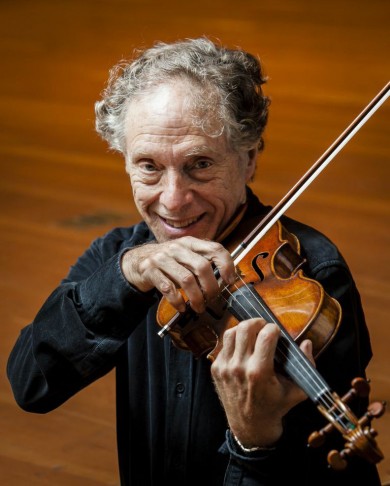Frost violin prof makes local debut with mixed program
No tougher test exists for a violinist than a solo recital. Lacking the support of a piano or orchestra, the performer risks every blemish in tone being heard and relies only on four strings to fill out the harmonies. And aside from the towering works of Bach, the unaccompanied violin repertoire is severely limited.
Yet is was with such a recital Sunday at Gusman Hall that Charles Castleman, the University of Miami’s new violin professor, introduced himself to South Florida. A former child prodigy who appeared on the Jackie Gleason and Lawrence Welk shows, Castleman had been a highly respected professor and department chair at the University of Rochester’s Eastman School of Music before being lured to Miami. Aside from a duet for two violins, Castleman was on his own for the recital, part of the Frost School of Music’s Festival Miami.
A striking stage presence, with a bouncy walk, a red vest and abundant unruly hair, he opened with what many consider the greatest work of all for unaccompanied violin, the Bach Chaconne. With a supple, steady bow arm and a clean playing style, he had the technique and style for the work.
His performance was technically uneven, but at most of the high points, he delivered. Some of the opening variations felt mechanical, with insufficient drama or sense of where the piece was going. And a few notes were shaky. Yet when the work entered into a complex web of arpeggios, he built it to a magnificent, sonorous climax. He brought a similar sense of the work’s grandeur and drama to the major-key peak that followed, his bow drawing ringing tones from the instrument. The final section, in which a frenzy of notes builds to a return of the opening theme, however, felt rushed and underpowered.
Castleman’s former Eastman student and now Frost colleague Scott Flavin, concertmaster at Florida Grand Opera, joined him for a duet by the 19th-century violinist and composer Louis Spohr. Spohr’s Duo for Two Violins Op. 67, No. 2, may be fun to play at home, but it’s forgettable music and far too long for its materials The performance was uneven, with the melodic line often lost in all the notes and a fair number of warbling, out-of-tune sounds coming from both violinists.
After intermission, Castleman returned alone to the stage for the contemporary Russian-American composer David Finko’s Lamentations of Jeremiah. This sounded much like you would expect from the title, with sobbing chords in the violin and an overall tone of tension and agitation. Notable was a passage toward the end in which Castleman got one of the few chances of the recital to reveal his gift for long, singing melody on the instrument’s highest string.
A pair of works by Astor Piazzolla followed, Tango Etudes Nos. 2 and 3. In the first, a slow, lyric melody, Castleman’s performance seemed too straightforward, without the easy sensuality the music seems to call for. But the second, with its jerky rhythm and rapid-fire notes, sparkled in his hands.
The finest playing of the afternoon came in the last work, the Violin Sonata No. 3 by the Belgian violinist and composer Eugène Ysaÿe. Considered by many to be the greatest virtuoso of the early 20th century—at least before Jascha Heifetz showed up—Ysaÿe composed music that made fearful demands on the violinist’s technique.
Castleman, who has recorded the complete Ysaÿe sonatas for Nonesuch, not only conquered the difficulties but entered fully into the spirit of this strange, post-Romantic music. The opening was eerie and full of tension, as he gradually built up the music from a few soft notes to a resonant tones at the upper range of the instrument. The main theme, which comes with rapid chords that make the most of the violin’s limited harmonic potential, came off as sturdy and dramatic, with the difficult, rapidly changing chords ringing out clearly. The soft, lightning-fast notes of the middle section were ghostly and fully in character with the work, yet with every note clear and accurate. He gave a frenzied, violent account of the finale, marching chords up the fingerboard to the abrupt conclusion.
Castleman received a warm response from the audience, with a standing ovation and repeated curtain calls. He played two encores. First was a buoyant account of the famous Preludio of Bach’s Partita for Violin in E Major. He followed with Ysaÿe’s take on that work, playing the Prelude of Ysaÿe’s Sonata No. 2, known as “Obsession,” which pairs quotations from Bach’s Preludio with Ysaÿe’s brutal responses. Played by Castleman in a virtuoso manner, the notes sounded so fast and clear that it sounded like several violins playing at once.
Festival Miami continues through November 7. festivalmiami.com
Posted in Performances
Leave a Comment
Mon Oct 19, 2015
at 3:03 pm
No Comments
